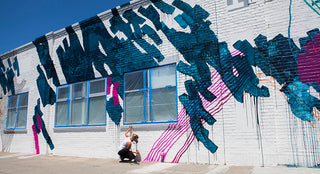Known for her bold, mixed media abstractions, Heather Day has been exhibiting works all across the country and has also found herself in a handful of pretty amazing private collections. When she’s not in the studio she spends her time—drawing materials and sketchbook in tow—in the great outdoors. She pulls inspiration from everything—the warm desert rocks, the cool blue of rushing rivers, and the textures of the famous California Redwoods. Her paintings reflect the natural world. The process is messy; she lays down huge sheets of plastic and dumps water and paint on her canvasses, allowing the elemental flow of water to dictate. This juxtaposition of chaos paired harmoniously with stillness is a perfect metaphor for nature and life.
We were able to catch up with Day during some down time in her beautiful loft home/studio to pick her brain a bit. Learn more about my friend, Heather Day, in our interview below.
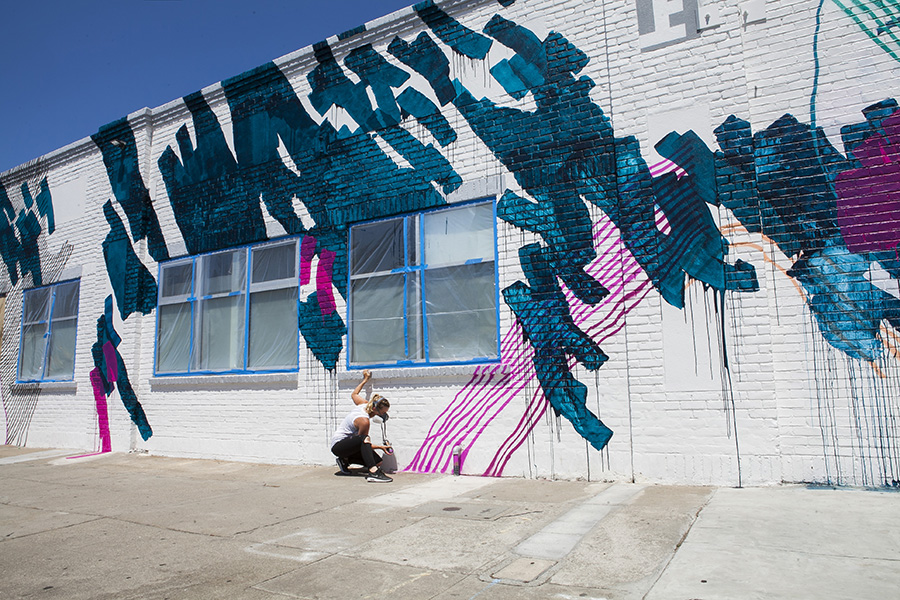
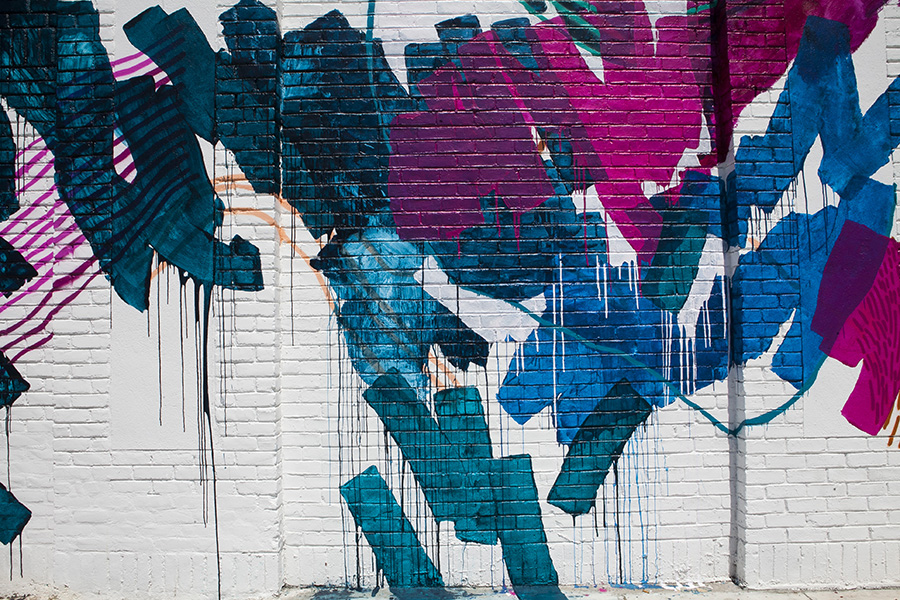
BROCK BRAKE: Your artist statement says that you draw inspiration from nature for your works. What aspects or characteristics of nature are you most drawn to and inspired by?
HEATHER DAY: Put simply, I’m attracted to nature. It’s an endless source of energy, movement, and intermingling textures that also provides an intimate and complex understanding of life. As a visitor to nature, you can be both an objective observer and participant, which is so exquisitely unique to our human experience. I especially love stepping back and watching nature converse with itself, seeing subtle relationships within landscapes.
I also visit to collect moments from nature, from the strength of a particular current, to the textures of tree bark, to build a vocabulary of marks that when added together, create a visual interpretation. My paintings are continuous abstract narrations of what I experience.
Nature contains so many juxtapositions; it can be serene and chaotic, it can be creative and destructive.
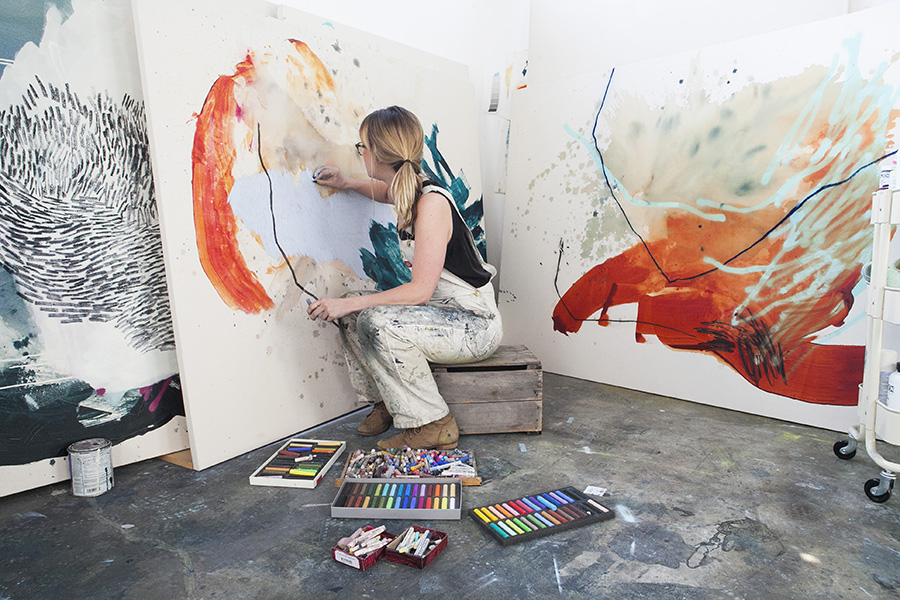
Do you meditate on these juxtapositions when it comes to your paintings? Does your process reflect both these characteristics? If so, separately or simultaneously?
I rely heavily on juxtapositions in my work, and I’d even say my painting process draws from the energy of moments from nature. A perfect example is Looking Up, a painting I finished last month that now functions as the basis for my current work.
Weeks prior to creating this piece, I had a surfing accident and haven’t been able to get back into the water since. This fear is a new feeling for me. I grew up near water and always associated it with serenity and familiarity. Now I see water as both dangerous and oddly comforting, a cognitive gray area that I pulled onto the canvas. Looking Up represents the tossing and turning under the water and the curiosity of what it would be like if I could see myself from the outside, looking up from the water, or watching myself move within the currents.
“Anything can be abstracted—a texture, an emotional reaction to nature, even lines. It’s all in the composition and perspective of a piece.”
During the creation of Looking Up, I started thinking about vulnerability in all things. Nature, self-expression, and the idea that most things are completely out of our hands are sources of vulnerability that inspire me. As an artist, I’ve found a deep parallel between being vulnerable and the creative process. There has to be a little fear and a little security. The process of creation is a vulnerable one, and feeling vulnerable allows creation. I find myself perpetually seeking balance on the canvas—from uncontrollable moments of making rapid marks or pouring paint to logistical controlled marks.
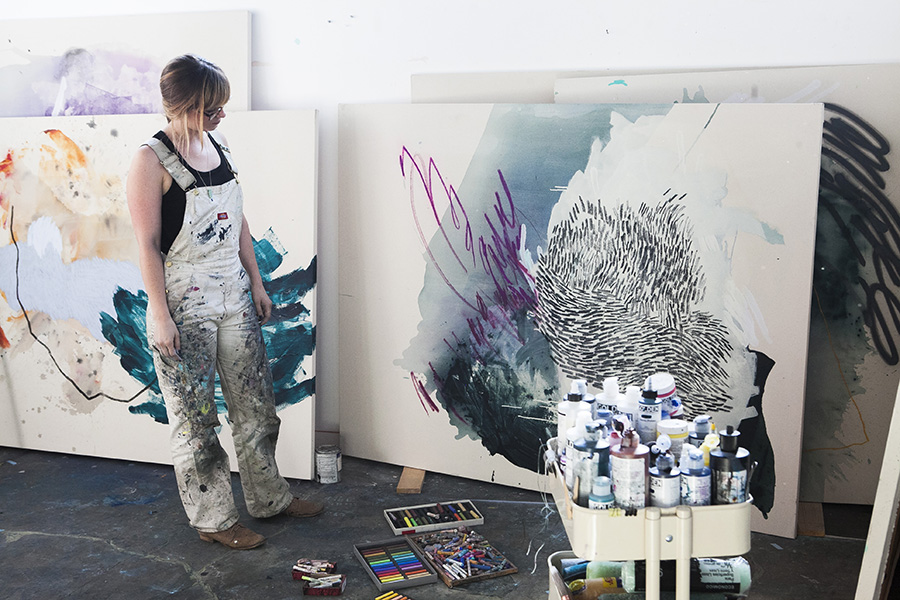
Why do you avoid direct imagery of nature in your work and choose to abstract it?
Years ago, during a high school art assignment on ballet dancers, I found myself fascinated by expressing movement rather than direct imagery. Finding a means of interpreting and recording the dancers’ movement drew me towards abstraction.
In my current work, I break down direct imagery taken from nature into reconstructions. I rely on tangible and clear details as starting points. Anything can be abstracted—a texture, an emotional reaction to nature, even lines. It’s all in the composition and perspective of a piece.
Do you make sketches before you work on a piece?
Many people find this surprising, but all my paintings act as sketches. Each forms the basis for new paintings. I take what I learn from one and move to the next piece. Nothing is ever planned or premeditated.
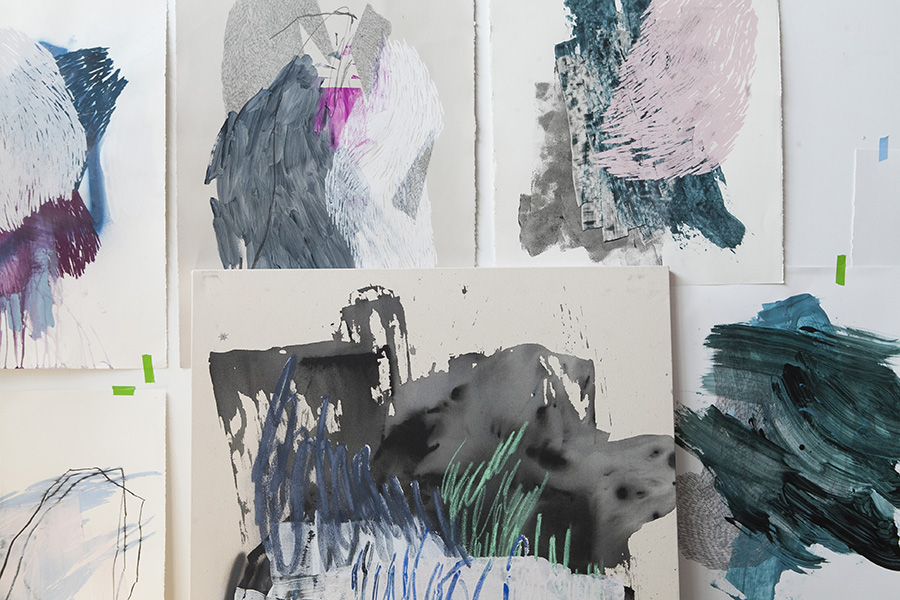
Could you walk us through your painting process? How do you begin a piece and what makes you decide to use certain materials when and how you do in a particular painting?
I typically have about twenty paintings in progress during most times of the year. These range from very large canvas works to small drawings on paper. This wide span is often due to recycling leftover paint into other paintings, allowing them to become studies or detailed thoughts of the larger piece I was working on.
“As an artist I’ve found a deep parallel between being vulnerable and the creative process. There has to be a little fear and a little security. The process of creation is a vulnerable one, and feeling vulnerable allows creation.”
I begin paintings with a quick mark. A blank canvas is very intimidating, so the faster I can make a mark and get moving, the smoother things go. From there, every mark is a reaction to the previous. Sometimes, I scrape paint across the canvas, or pour buckets of water and watch what happens. It’s all an experiment in manipulation.
A huge part of my process involves physical strength. I’ll pick up the canvas and let gravity push the water around. I’m walking and stretching and pouring. Paint and water get everywhere, and clean up requires a mop and rag.
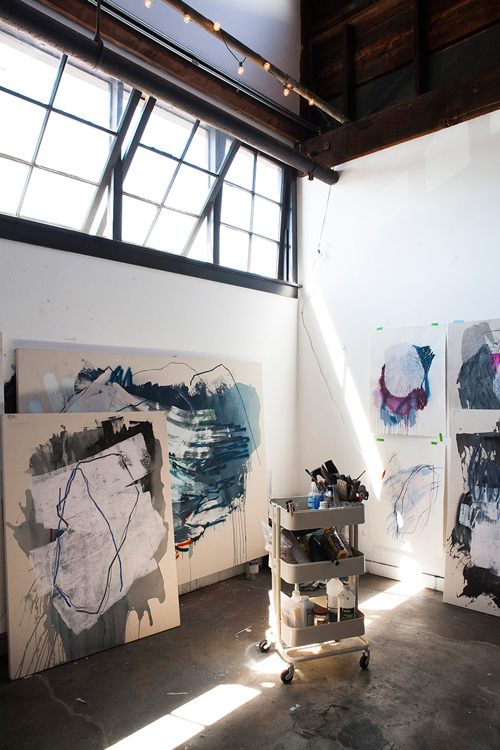
Does the accidental play a role in your process? It seems like it would in order to keep things organic, right?
Absolutely. Accidental moments keep my work unrestricted and a little unpredictable. This doesn’t always work to my advantage though. Sometimes a piece could be almost complete, but ruined by an an unfriendly accident. For example, if I pour on a transparent layer and it doesn’t go as planned, I could lose the piece. Though it can be frustrating, I’ve found an appreciation for accidents as they bring unexpectedness. I never want to create formulaic art, and thanks to accidents, I never will.
Who are some artists that have or currently influence you to create?
I’m currently interested in the work of Katharina Grosse, Sam Gilliam, Portia Zvavahera, Richard Tuttle, and Helen Frankenthaler. I also recently started reading poetry by Dorothea Tanning, who’s also known for her surrealist paintings from the 1950’s.
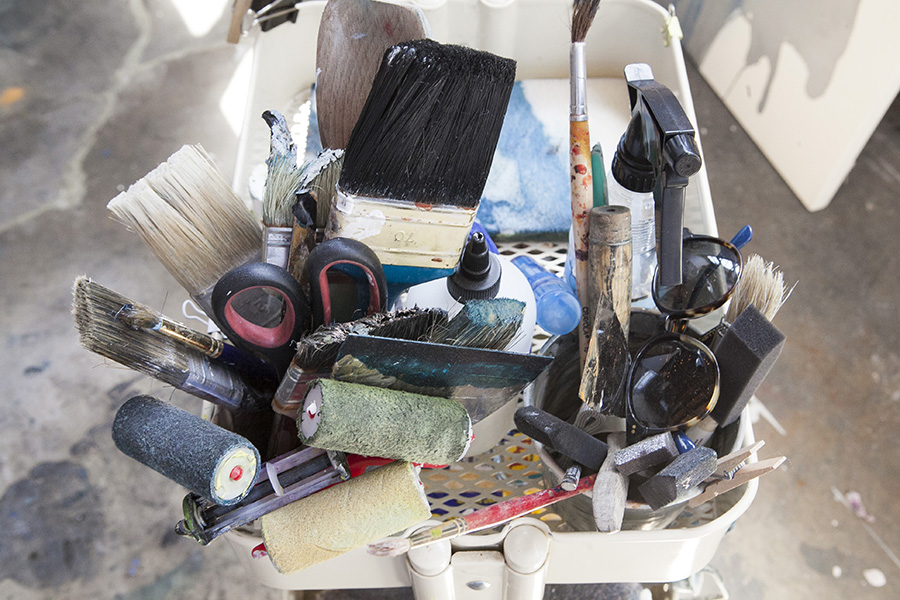
How do you think society treats you as a female artist? What are the advantages and disadvantages?
In the world of fine art, gender inequality is a disappointing reality. We are much more likely to see women depicted as objects of art than actual art created by successful female artists. Moreover, women are seldom talked about in art history. Seeing this inequality firsthand frustrates me to no end. I support all artists, of all genders, but I do have problems with the gender inequality that is so blatantly present.
My biggest concern as a female painter is perception and identity. For several years I didn’t want people to associate gender with my work, thinking it would affect how people viewed my art. Today I am proud to associate my gender with my art.
You are a very busy artist, with multiple projects happening with big brands. How do you keep yourself balanced with so much going on? What are some promises you make to yourself to keep yourself grounded and sane?
To be honest, I don’t necessarily keep myself balanced. I need asymmetry in my life to stay productive. Before I committed to being a full-time artist, I was hard on myself about sticking to a consistent schedule, but this was almost two years ago!
After I left my comfy design job to practice art full time, I felt pressured to work the typical nine to five hours. But trying to constrain myself and my process to particular hours felt too rigid, and I realized that I needed to redefine “normal working hours.” Now, at seemingly odd times, I work on several projects at a time. I start early and finish late, usually with a nap in the middle. I’m most creative in the evenings and try to take advantage of that with late night studio hours… My calendar keeps me on task. It houses my meetings and social obligations, but also my schedule for paintings and projects to complete. Plus, as I’ve been working with more brands lately, my schedule has to be as flexible as possible to accommodate both creative and corporate schedule requirements.
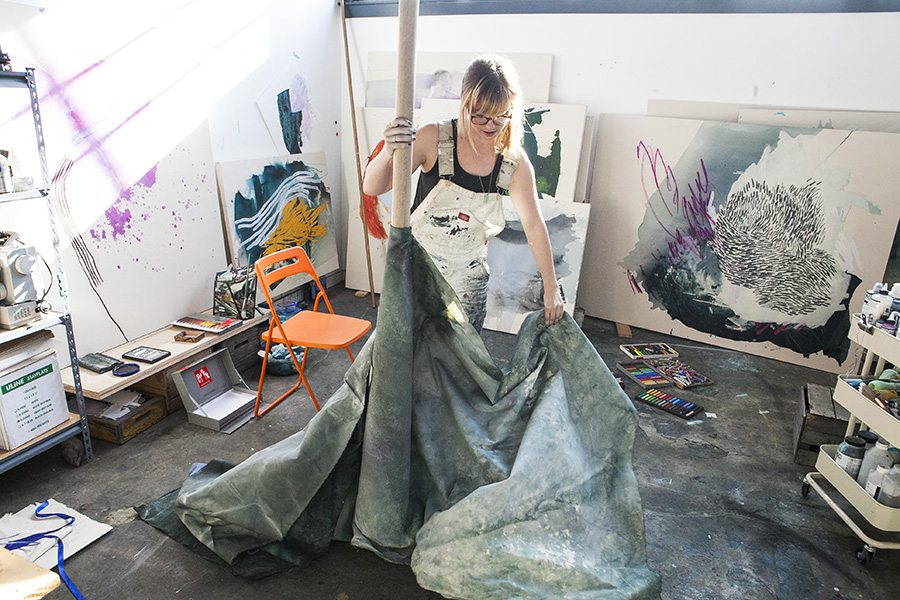
You’ve written an open letter on your website regarding how you approach partnerships with brands. Could you summarize your philosophy here?
Over the last few years I’ve been lucky to have been approached by several different brands, each seeking a collaboration. As a fine art artist, I felt a sense of identity crisis and confusion on how I’d be viewed if I accepted partnerships with companies. I didn’t want to be seen as a corporate sell-out.
In the letter, I explained how partnerships secure funding for more experimental projects outside of painting, which is valuable because of the buffer created between the need to expand artistically and the need to earn a living. I also discussed how I decide whether or not to work with a company and the lost idea of patrons of the arts.
I ultimately wanted to change ideas about how artists can work and create. We live in a time where it’s ok for an artist to work as a singular entity, without fear of being a “sell out” by accepting partnerships and without needing galleries to necessarily survive.
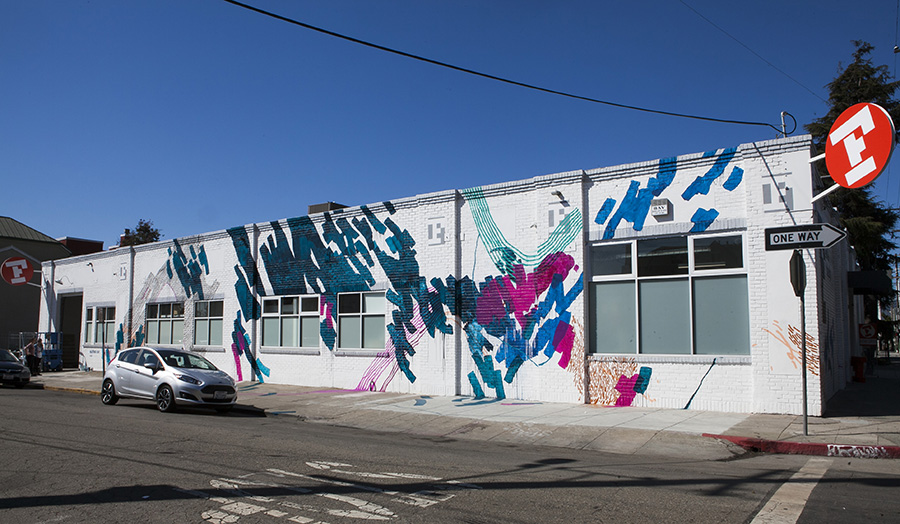
***
heatherdayart.com. Follow Heather on Twitter @heatherdayart and Instagram @heatherdayart.

